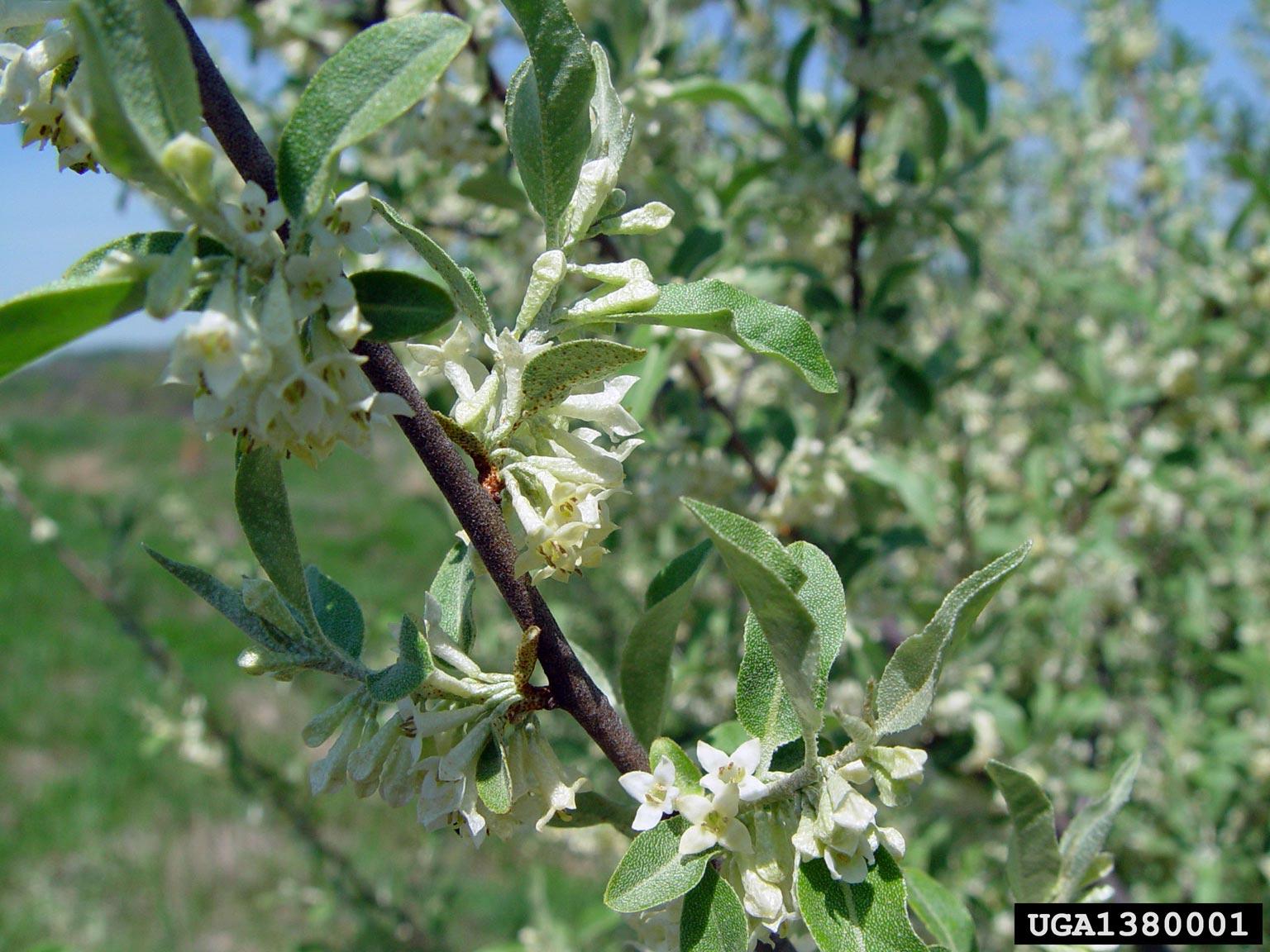About autumn olive (Elaeagnus umbellata)
Life cycle and background
This deciduous woody plant was introduced from Asia to the United States in 1830. Autumn olive was used for ornamental gardens, windbreaks, wildlife cover, and restoration of soils degraded by deforestation and mining. It displaces native plants by creating dense shade, altering soil chemistry, and interfering with natural plant succession. The related Russian olive (Elaeagnus angustifolia) is also invasive in Maryland.
Growth habit
Fast growing and invasive. This deciduous, multi-stemmed shrub or single trunked tree can grow to 20’ or more in height. Leaves are alternate along the stems, ovate to lanceolate, with smooth margins. Silver scales are apparent on leaves, buds, and stems. Undersides of the leaves have a silvery sheen. Small, creamy yellow, aromatic flowers bloom in the spring. Produces small round reddish fruits dotted with scales.

Reproduction
Produces a large amount of seeds with a high germination rate. Seeds are dispersed by birds and mammals. Regrows easily when cut.

Conditions that favor growth
Sun and partial shade. Prefers well-drained soils. Drought tolerant. Tolerates salt and soil pH as low as 4.0. Most often found in open forests, fields, and along streams and floodplains.
What to plant instead
Winterberry (Ilex verticillata), spicebush (Lindera benzoin), gray dogwood (Cornus racemosa), Southern wax myrtle (Morella cerifera).
Controlling autumn olive
-
Autumn Olive | Penn State Extension
Additional resources and references
Kaufman, Sylvan Ramsey & Wallace Kaufman. 2007. Invasive Plants: Guide to Identification and the Impacts and Control of Common North American Species.
Maryland Invasive Species Council. March 2010. Despite the Lycopene, Still a Bad Actor: Autumn Olive.
Plant Invaders of Mid-Atlantic Natural Areas
Swearingen J., K. Reshetiloff, B. Slattery, and S. Zwicker. 2002. Plant Invaders of Mid-Atlantic Natural Areas. National Park Service and U.S. Fish & Wildlife Service, Washington, DC.
Compiled by Christa Carignan, reviewed by Debra Ricigliano, University of Maryland Extension, 5/2018
Still have a question? Contact us at Ask Extension.
 English
English العربية
العربية Български
Български 简体中文
简体中文 繁體中文
繁體中文 Hrvatski
Hrvatski Čeština
Čeština Dansk
Dansk Nederlands
Nederlands Suomi
Suomi Français
Français Deutsch
Deutsch Ελληνικά
Ελληνικά हिन्दी
हिन्दी Italiano
Italiano 日本語
日本語 한국어
한국어 Norsk bokmål
Norsk bokmål Polski
Polski Português
Português Română
Română Русский
Русский Español
Español Svenska
Svenska Català
Català Filipino
Filipino עִבְרִית
עִבְרִית Bahasa Indonesia
Bahasa Indonesia Latviešu valoda
Latviešu valoda Lietuvių kalba
Lietuvių kalba Српски језик
Српски језик Slovenčina
Slovenčina Slovenščina
Slovenščina Українська
Українська Tiếng Việt
Tiếng Việt Shqip
Shqip Eesti
Eesti Galego
Galego Magyar
Magyar Maltese
Maltese ไทย
ไทย Türkçe
Türkçe فارسی
فارسی Afrikaans
Afrikaans Bahasa Melayu
Bahasa Melayu Kiswahili
Kiswahili Gaeilge
Gaeilge Cymraeg
Cymraeg Беларуская мова
Беларуская мова Íslenska
Íslenska Македонски јазик
Македонски јазик יידיש
יידיש Հայերեն
Հայերեն Azərbaycan dili
Azərbaycan dili Euskara
Euskara ქართული
ქართული Kreyol ayisyen
Kreyol ayisyen اردو
اردو বাংলা
বাংলা Bosanski
Bosanski Cebuano
Cebuano Esperanto
Esperanto ગુજરાતી
ગુજરાતી Harshen Hausa
Harshen Hausa Hmong
Hmong Igbo
Igbo Basa Jawa
Basa Jawa ಕನ್ನಡ
ಕನ್ನಡ ភាសាខ្មែរ
ភាសាខ្មែរ ພາສາລາວ
ພາສາລາວ Latin
Latin Te Reo Māori
Te Reo Māori मराठी
मराठी Монгол
Монгол नेपाली
नेपाली ਪੰਜਾਬੀ
ਪੰਜਾਬੀ Afsoomaali
Afsoomaali தமிழ்
தமிழ் తెలుగు
తెలుగు Yorùbá
Yorùbá Zulu
Zulu ဗမာစာ
ဗမာစာ Chichewa
Chichewa Қазақ тілі
Қазақ тілі Malagasy
Malagasy മലയാളം
മലയാളം සිංහල
සිංහල Sesotho
Sesotho Basa Sunda
Basa Sunda Тоҷикӣ
Тоҷикӣ O‘zbekcha
O‘zbekcha አማርኛ
አማርኛ Corsu
Corsu Ōlelo Hawaiʻi
Ōlelo Hawaiʻi كوردی
كوردی Кыргызча
Кыргызча Lëtzebuergesch
Lëtzebuergesch پښتو
پښتو Samoan
Samoan Gàidhlig
Gàidhlig Shona
Shona سنڌي
سنڌي Frysk
Frysk isiXhosa
isiXhosa